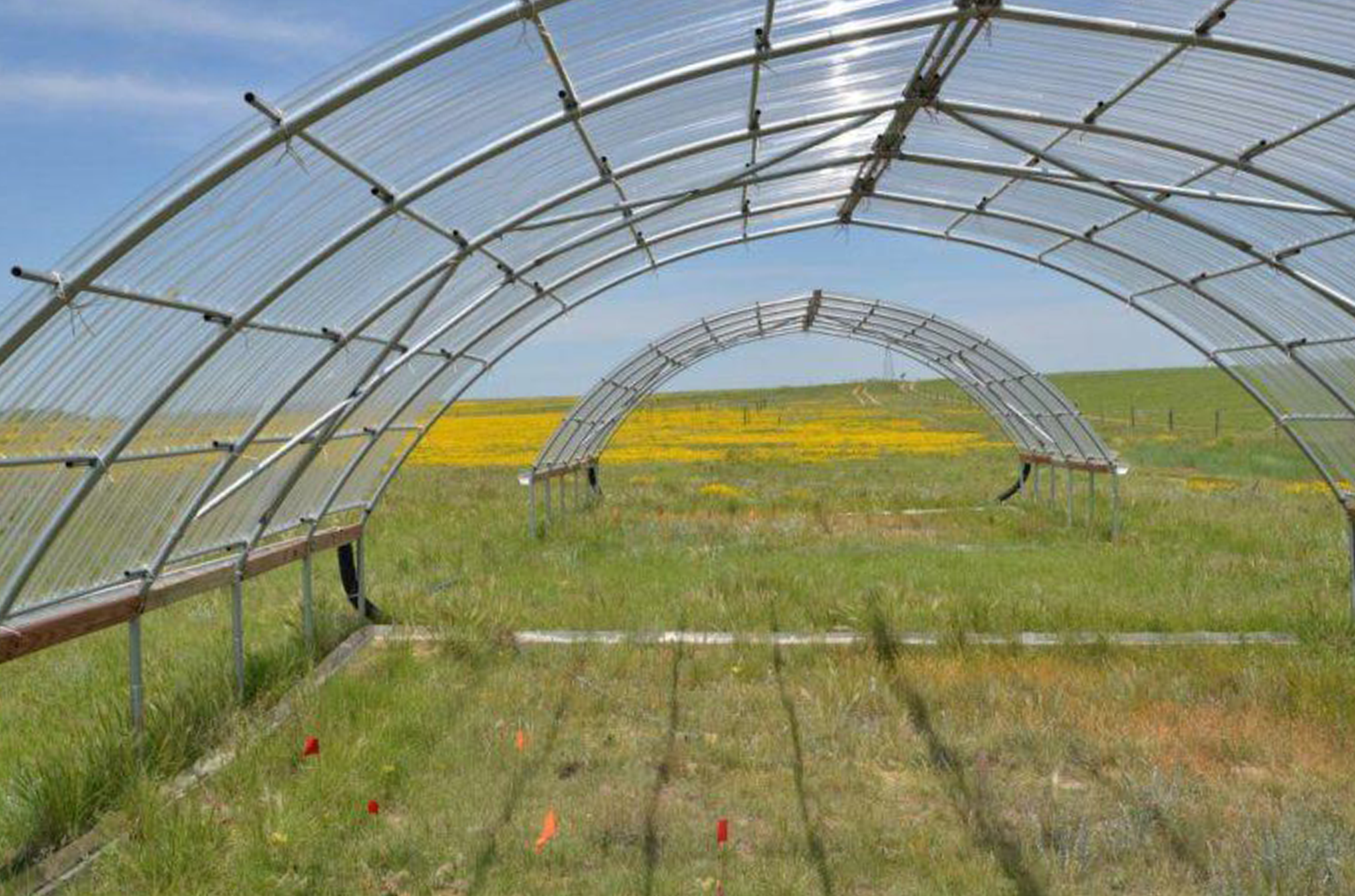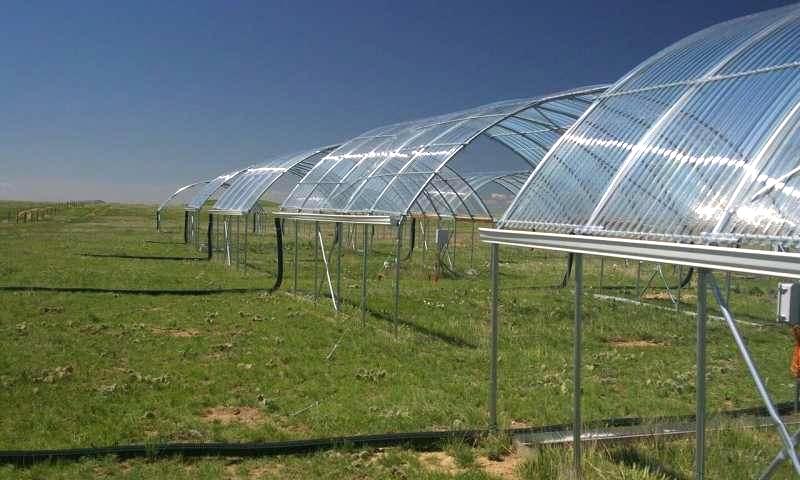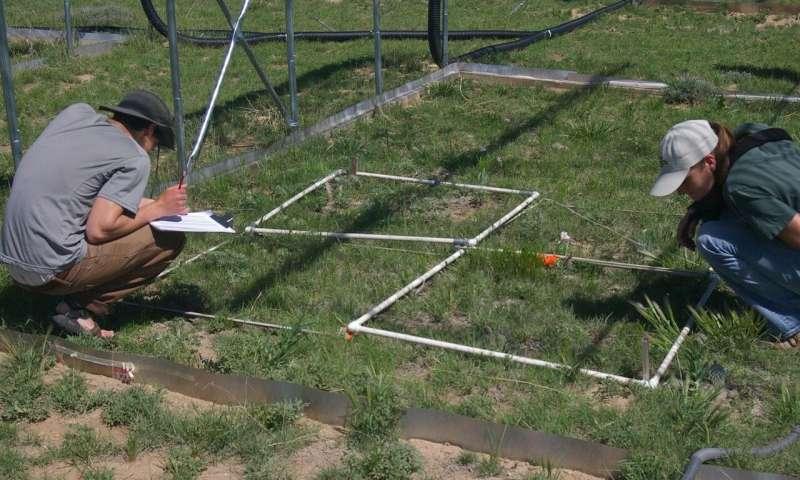
Courtesy of Alan Knapp

Courtesy of Alan Knapp
Nearly a century after the Dust Bowl, a strange arc-shaped structure protrudes from the central plains of Kansas. Its latticed beams stand out against the patched greens and yellows of the plain’s horizon, giving the grassland a futuristic appearance. The assembly resembles the skeleton of an abandoned particle accelerator, or a translucent jungle gym.
This structure is not a playground but a science experiment. Each archway creates an artificial drought environment designed to restrict rainfall to simulate Dust Bowl conditions. Colorado State University professor of biology and senior ecologist Alan Knapp and his team set up these structures in Kansas and Wyoming starting in 2012.
By controlling the amount of rainfall each patch of grass received over a four-year period, the team was able to observe how native grassland plants respond to extreme drought. In doing so, they tackled an 80-year mystery for what has been called the “Dust Bowl Paradox.” During the 1930s, plagued by little rain, “cool-temperature plants” mysteriously encroached into the hottest and most drought-stricken regions of the plains, overtaking the warm-temperature plants we’d expect to survive.
The artificial drought experiment is a timely one, as climate change produces more drought and extreme heat in grasslands today. Farmers globally, especially ranchers, depend on what grows on temperate grasslands, which also have value as natural carbon sinks. Even though they are rich in biodiversity, temperate grasslands are the least protected and most endangered biome in the world, according to a 2010 article published in the Great Plains Research journal.

Because ranchers rely on a single crop to sustain their livestock, unpredictable rainfall patterns—and the invasion of non-native grasses—can compromise the success of an entire ranch.
“If you’re trying to make a living off of grass on the Great Plains, you might as well have a drought plan,” said Barth Crouch, state coordinator of the Kansas Grazing Lands Coalition (KGLC). “Because it’s gonna happen.”
Knapp’s research offers insights into patterns to expect during droughts—particularly “megadrought” growing seasons. In the United States, the Great Plains currently teeters on the brink of what scientists call an “emerging megadrought,” according to a 2020 study in Science.
The Dust Bowl of nearly a century ago is a key case study in understanding contemporary drought science. In the 1930s, a decade of extreme drought and heat waves ravaged the Great Plains, which span approximately 1,125,000 square miles, or one-third of the United States. Destructive farming techniques across the region worsened the Dust Bowl crisis by causing widespread erosion and howling dust storms that buried entire farms, leading to an estimated $1.9 billion just in agricultural losses. Farm devastation wasn’t the only result: the drought’s continued effect on plant communities was evident for 20 years, Knapp said.
Against all odds, cool-temperature plants began to overtake warm-temperature plants and take their place in grasslands, raising an important question: Why do some plants survive after drought and others don’t? More specifically, what caused cool-temperature plants to abruptly spread into 135,000 miles of arid land in the southern-central United States? The Dust Bowl Paradox revolves around that question.
Knapp said he didn’t start his studies to “solve” the Dust Bowl Paradox. “We studied how [plants] respond to drought in general,” Knapp said, “as a potential mechanism rather than the solution.”
In doing so, his team confirmed the importance of the seasonal regularity of rainfall. It’s not the temperature or amount of rainfall a grassland receives that influences what grows, they found. It’s the timing of rainfall that dictates which plants prosper—and which don’t—during and after a drought.
“Cool-temperature plants” are plants adapted to thrive during a wider time span of rainfall (meaning rainfall happens earlier, in cool months, as well as during summer months). During droughts, that’s exactly what happens: Rain falls proportionately more often early in the season. This perfect matchup explains why “cool-temperature plants” paradoxically thrived during the Dust Bowl, according to the 2020 Proceedings of the National Academy of Sciences article by Knapp and collaborators.
“The Great Plains have always been dealing with long term changes, and drought is one of them. It’s actually more of the norm – the wet years are the strange things. It’s the timing that’s changed; off and on,” Crouch said. Through his work with the Kansas Grazing Lands Coalition, Crouch works with ranchers on a daily basis to help them respond to unpredictable drought conditions. In this era of climate change and increasing major weather events, many ranchers are preparing for (and experiencing) major vegetation shifts.
When it comes to soaking up rainfall and fixing CO2 in high temperatures, warm-temperature native grasses simply do the job better. Cool-temperature invaders, and woody plants, produce more runoff and add unpredictability to ranchers’ seasonal schedules.
Knapp’s findings suggest that grassland managers will have to adjust to the erratic growth seasons and decreased water efficiency that come with the invasion of cool-temperature grasses. The shift to cool-temperature grasses could even result in hotter summers, Knapp said.

Knapp and his team are now gathering data on another chapter of the Dust Bowl: recovery. For the next 20 years, Knapp intends to take his team on several “road trips” to check on their artificially drought-stricken plots. If the Dust Bowl vegetation took 20 years to recover, one of the next mysteries to solve is the timespan of recovery for Knapp’s drought. How long will it take for his plots to bounce back?
Maintaining an artificial drought is no easy feat. His team faced setbacks from natural drought, long commutes, and even onsite vandalism at the arches. But the hard-won research serves an important purpose: foresight.
When it comes to facing a future of emerging megadrought in the United States, every pattern and paradox matters—even mysteries dating back to the Dust Bowl.
Among the growing network of ecologists racing to prepare us for a drier and drier future, Knapp’s jungle gym science experiments—and his tenacity to tackle unanswered conundrums from the past—offer key insights into the preparations farmers will need to make across the American Mid-West.